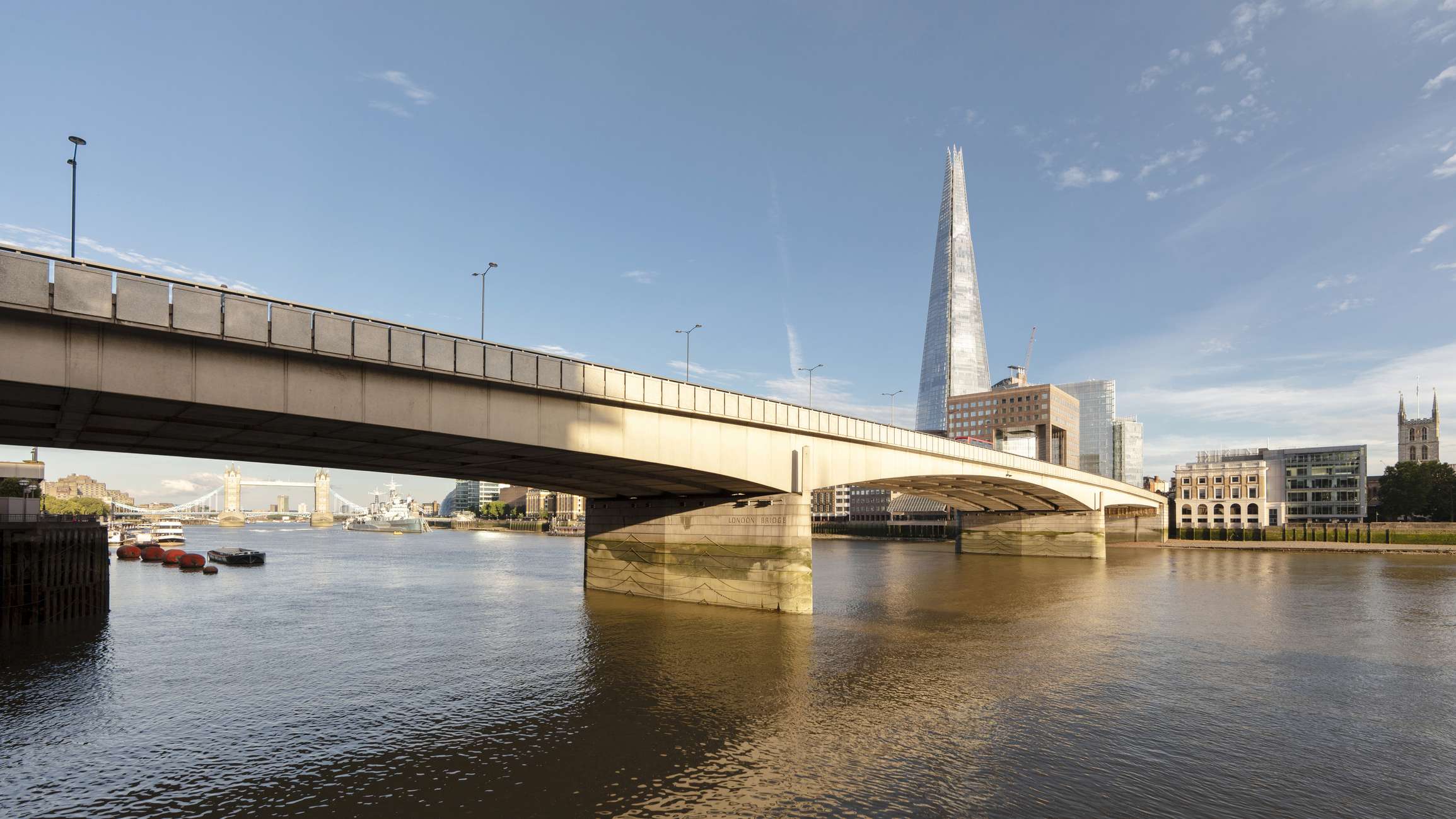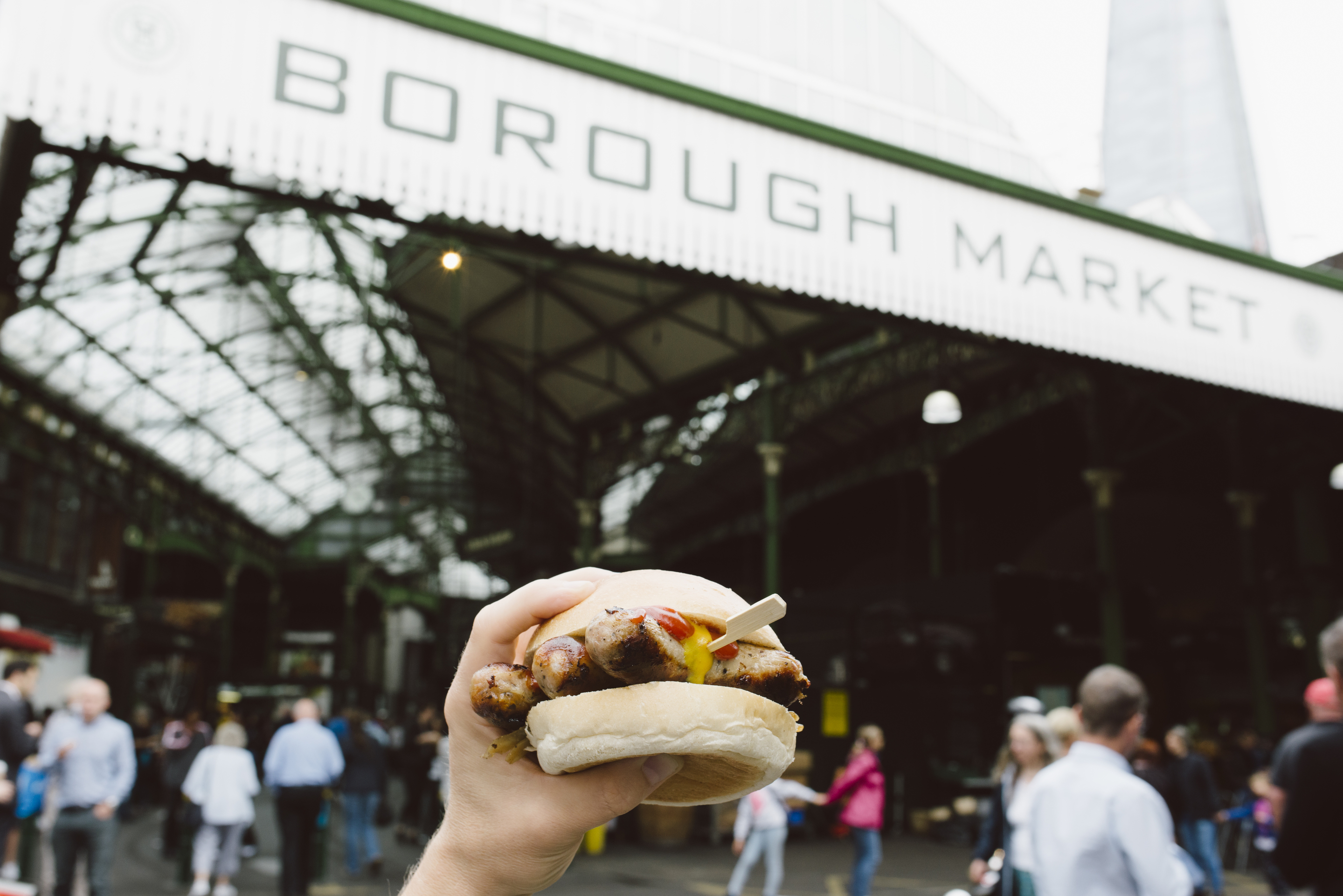You’ve heard the song, but do you know the history behind one of London’s most famous bridges? Today, London Bridge is a concrete and steel structure, crossing the Thames for over 50 years. It sits alongside another, more iconic crossing – Tower Bridge.
The storied past of London’s bridges, including the original Roman London Bridges, has helped shape the city as we know it today.
What’s in this guide?
- What to see at London Bridge
- London Bridge history and facts
- Restaurants, bars and shops near London Bridge
What is the difference between London Bridge and Tower Bridge?
London Bridge is often confused with its neighbour, Tower Bridge. The two look nothing alike, but Tower Bridge is one of London’s defining landmarks, so it makes sense for many people to assume it’s named after the city.
How to get to London Bridge
Getting to London Bridge is easy, thanks to the train and underground stations which share the landmarks name. London Bridge train station is the oldest in Central London and one of the oldest globally, open since 1836. There are lots of landmarks and attractions nearby. At the same time, the bustling London Bridge & Borough neighbourhood is home to many of the city’s best restaurants, bars and pubs.
From London Bridge train station, you can easily walk to Southwark Cathedral or the iconic Tower Bridge, crossing over to visit the Tower of London, The Shard, Shakespeare’s Globe and the Tate Modern are also within walking distance.
If you want to take the tube to London Bridge, hop on the Jubilee line (grey) to – you guessed it – London Bridge station.
What to see at London Bridge
Interested in exploring London Bridge? The new structure opened in 1973 and is one of the busiest crossings in the city. Compared to its neighbours, London Bridge isn’t much to look at. But it’s worth learning about the history of the crossing and the significant role London Bridges have played in the city’s past.
The modern London Bridge we know today was designed by architect Lord Holford, working with a team of engineers, and was built between 1967 and 1972. The 254-metre bridge was built in the same place as its predecessor by strategically adding sections and transferring traffic between new and old parts of the bridges.
Queen Elizabeth II opened London Bridge in 1973.
London Bridge lights
Strips of red light were added to London Bridge and others for Remembrance Day in 2004. The lights were part of a nighttime flight along the river by wartime planes, celebrating the lives of those lost in battle.
After the event, the lights were removed from the rest of the city’s crossings. Thankfully, London Bridge’s were left in place. They’re often switched on at night as a colourful addition to the urban landscape.
London Bridge history and facts
The London Bridge of today is a modern addition. So why’s it important? The history of bridges in this spot stretches back to the mid 18th century when the oldest London Bridge was the only crossing in the city.
Roman and medieval bridges
London Bridge’s fame is a consequence of the long history of crossings in the area. We know that Roman roads leading to London were built around 50AD. A crossing over the Thames would have meant a significant shortcut between southern ports and Roman towns. The first bridge in London would have been made from timber in the cantilever or arched style.
When Roman rule in Britain ended, Londinium (the Roman name for London) was abandoned, and the bridge fell to ruin.
Repair, ruin and repair
Between the Roman rule and King Henry II’s reign, London Bridge was rebuilt, destroyed, repaired, blown down by a tornado, rebuilt again and burnt down. Then came Henry…
Old London Bridge
When his friend Thomas Becket, the Archbishop of Canterbury, was murdered, King Henry II commissioned a new stone bridge with a chapel at its centre. This would be the Chapel of Saint Thomas on the Bridge, the official starting point for pilgrimages to the Canterbury shrine.
The price of building this impressive crossing and chapel would have been enormous. Wool and sheepskin taxes were introduced to help cover the cost, and houses were built on the bridge to help fund its upkeep. Construction was finished in 1209.
Living on Old London Bridge
In the late 14th century, there were 120 houses on Old London Bridge. The houses started out with just two storeys. They were developed, merged together and enlarged over time, so by the 17th century, almost all had four or five floors.
The first floors of London Bridge houses were shops, making the crossing one of London’s main shopping streets at the time.
London Bridge houses were subjected to many of the city’s fires throughout the 16th and 17th centuries. One blaze in 1633 destroyed buildings on the north side of the bridge. When the Great Fire struck in 1666, the gap remained where houses hadn’t been rebuilt, stopping the fire from spreading over the river.
John Rennie’s 19th-century London Bridge
In 1756, the London Bridge Act gave the City Corporation permission to buy all the houses on the bridge to be demolished, making way for a new crossing.
The so-called New London Bridge was designed by architect John Rennie; he proposed a conventional design with five stone arches. It was built 30 metres west of the 19th-century bridge, which stayed open while the new structure was under construction. Work started in 1824 and was officially opened in 1831.
By 1924, the bridge’s east side had sunk a couple of inches into the Thames, and surveys showed that it would continue dropping by about an inch every eight years. It would need to be replaced – again!
The modern London Bridge
When the modern replacement was ready, the 19th-century bridge was taken to a new home in Lake Havasu City in Arizona, where it remains to this day.
The current London Bridge was built between 1967 and 1972 and opened by Queen Elizabeth II in March 1973. Construction was partly paid for by the sale of the last bridge.
Restaurants, bars and shops near London Bridge
Though Old London Bridge was one of the busiest shopping streets in London, today’s crossing is exclusively for cars and pedestrians. But the London Bridge area is full of excellent restaurants, bars and pubs. Not to mention plenty of shops, making it a great location to spend some time in London.
Restaurants and cafés
Head to Nat.ive, a welcoming spot serving fresh, seasonal food made with foraged and sustainable ingredients. Bar Duoro champions small plates, complemented with a purely Portuguese wine list. Meat lover? Make a beeline for Vivat Bacchus, a South African wine specialist known for their meat and cheese.
More excellent restaurants in London Bridge include:
- Casa do Frango
- Lupins
- Restaurant Story
- Lobos
- Mango
- Boro Bistro
If you’re looking for something lighter, like breakfast, brunch or lunch in London Bridge, there are plenty of great cafés and coffee shops too:
- The Breakfast Club
- Where the Pancakes Are
- Grind
- Lantana Café
- WatchHouse
Pubs and bars
Fancy a quick pint after visiting London Bridge? Maybe you want to settle in with a glass of wine and people-watch. London Bridge boasts some of the best pubs and bars in the city.
The Rose and Crown serve a vast selection of craft beers and award-winning burgers, making it an easy choice for drinks or a bite to eat. The Market Porter is another favourite London Bridge pub with a varied beer, wine and spirit selection; bonus – it’s in the area’s ever-popular Borough Market. The George Inn dates back to 1543 and is the only galleried coaching inn to survive in the city.
More great pubs in the area include:
- The Old King’s Head
- The Horseshoe Inn
- The Barrowboy and Banker
- The Old Thameside Inn
- The Rose
Shopping near London Bridge
Find more than 100 shops in the London Bridge area, including high-street brands, independent vintage shops, boutiques and more.
You might recognise Reiss, Pandora, Next, Whistles and Ted Baker. If you love shopping for fashion, you might find a new favourite. More clothes shops in the area include Hawes & Curtis, Charles Tyrwhitt and Kat Maconie. Whatever you’re shopping for, take time to enjoy a stroll around London Bridge – you never know what you might find.
Taking the train to London?
You can easily reach London by train from within the UK, as well as other major European cities, thanks to the many high-speed rail connections available.
If you're already in the UK and heading into London, you can get from Edinburgh to London in 4h, from Manchester to London in 2h 3m, from Glasgow to London in 4h 28m and from Liverpool to London in m. Some of the most popular international routes include Paris to London (2h 17m), Brussels to London (2h 1m) and Amsterdam to London (4h 42m).
Need more information about travelling to London by train? Check out our dedicated page to trains to London.



